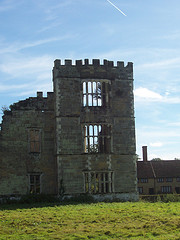Cowdray
Home
of
the
Earl
of
Southampton's
mother,
and
where
he
was
born
Cowdray Castle saw its heyday in the time of Browne's son,
Sir Anthony Browne the Second.
An important man in the court of Queen Elizabeth the First,,
he was highly trusted by the Queen
and sent by her
on missions overseas to act on her behalf.
Browne entertained the Queen at long parties held at Cowdray
in her honour, parties that lasted for days with great banquets
and entertainment.
But all was not well for - some might say - the family was living
on borrowed time.
At the time that the first Anthony Browne had been awarded Cowdray
he took control also of Battle Abbey (in East Sussex).
After razing many of the church buildings to the ground
he evicted the monks and, as a result, was cursed by the last monk
of Battle Abbey who said that his family line would perish by fire or water.
Just over 250 years later in 1793 the 8th Viscount Montague,
descendant of the Browne family, was drowned in a boating accident -
trying to shoot a waterfall on the River Rhine.
A week later Cowdray burned to the ground, leaving the ruins we see today.
(An alternative account puts events in the other order -
that the house was burned down by workmen
preparing for the homecoming and wedding of Viscount Montague,
and that he died abroad one month later
immediately after receiving a letter telling him of the fire).
The Cowdray estate passed to the Viscount's sister
who married and had two sons.
They were drowned in a boating accident in 1815.
http://www.odd-stuff.info/follies/cowdray.htm
......................................................................................................................................................................................
More on the castle
The castle on St Ann's Hill, Midhurst,
was founded by Roger of Montgomery soon after the Norman Conquest.
Roger was an important supporter of William the Conqueror
and was given extensive lands in Sussex and the Welsh Marches.
The castle site is a natural strongpoint,
giving good views over the Rother valley and controlling access to the area.
By the 1180's the castle and manor of Midhurst was owned by the de Bohun
family, including the castle buildings of a hall,
chapel and the castle defences.
It seems to have been abandoned for a new manor house
on the floor of the river Rother's valley in the 1270ís.
This was a moated and defended house called la Coudraye (the hazel woods),
its exact location relative to the Cowdray Ruins is not known.
More on Cowdray Ruins
Cowdray House was begun by Sir David Owen in the 1520's
and completed by its second owner, Sir William Fitzwilliam, earl of Southampton.
It consists of a range of buildings around an inner courtyard
with a formal garden, kitchen garden
and the great approach across the causeway from Midhurst.
There is a great wealth of historical information about the house and its inhabitants.
One of the fascinating survivals is the Household Book of Rules,
which explains the etiquette and practises of an important Tudor household.
Cowdray's Tudor kitchens were in a detached building
so that they would not cause a fire throughout the whole building.
This means that they survived the fire that destroyed the house.
The earliest English language cookery book was by a former chef of Cowdray
so it is possible to explain the types of food and their ornate presentation at table.
There were minor repairs to the house during the 200 years
in which the Browne family occupied it.
The family remained Catholic after the Reformation and this influenced the house and town.
However, in 1793 whilst builders were undertaking works,
a fire began in the north range which spread throughout the house.
The fire raged unchecked (the household's fire engine was in a locked out-building
whose key could not be found) and the house was not reoccupied as the last Browne family member
drowned in Germany within a few months of the fire.
http://www.chichester.gov.uk/enjoy/heritage___leisure/cowdray_and_midhurst_heritage_.cfm#8
........................................................................................................................................................................................
Cowdray House
From Wikipedia, the free encyclopedia
Cowdray House is constituted of the ruins of one of England's great houses,
outside the West Sussex village of Midhurst.
Its destruction by fire in 1790 was almost total,
but what remains hints at its former glory.
Started in the early 16th century on the site of an earlier building,
this noble house became the home of the Browne family,
later the Viscounts Montague
and a repository of some of the key artefacts from English history.
Its heyday fell during the Tudor period ;
architecturally it compared to many of the great palaces and country houses of that time.
Currently the site is undergoing a major preservation project,
which will include new visitor facilities. It is due to re-open at the end of 2006,
as the roofless ruin of Cowdray House.
http://en.wikipedia.org/wiki/Cowdray_House
......................................................................................................................................






pictures
by
felinebird
at
flickr -
pictures
licensed
under
creative
commons
home
or
index





